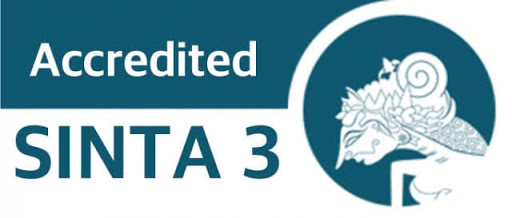DEVELOPING INTEGRATION TECHNIQUES MODULE TO IMPROVE MATHEMATICAL CREATIVE THINKING ABILITY IN INTEGRAL CALCULUS
Abstract
This study aimed to 1) to find out the effectiveness of the integration technique module in integral calculus learning, and 2) to find out the increase in the mathematical creative thinking ability after implementing the integration technique module in integral calculus learning. The development of module was conducted by using ADDIE model with five stages: Analysis, Design, Development, Implementation, and Evaluation. The subjects in this study were 16 students in the 3rd semester of Mathematics Education Study Program, the Faculty of Teacher Training and Education, Universitas Riau. The research instruments were an expert validation questionnaire, a student response questionnaire, and a mathematical creative thinking ability test. The data obtained were analyzed by using quantitative and qualitative descriptive analysis methods. Based on the results of the validity test, the integration technique module was declared valid and suitable for students to use in the integral calculus course. Judging from the results of the module practicality test, the average percentage of practicality values was 77.8125 and was in the practical category. Referring to the results of the module effectiveness test, the n-gain average of students' mathematical creative thinking abilities was 0.64 and in the medium category. Because the integrated engineering module met the criteria of validity, practicality, and effectiveness, it could be stated that the developed integration technique module improved students' mathematical creative thinking skills in the integral calculus course.
Keywords
Full Text:
PDF (BAHASA INDONESIA)References
Akbar, S. (2013). Instrumen Perangkat Pembelajaran. Bandung: Remaja Rosdakarya
Amidi. (2018). Kemampuan Berpikir Kreatif Mahasiswa Semester 1 pada Mata Kuliah Matematika Dasar. Prisma, 1, 936 – 942
Arhasy, E. A.R, dan Mulyani, E. (2017). Kontribusi Model Problem Based Learning Berbantuan Media Software Maple Terhadap Kemampuan Berpikir Kreatif Matematis dan Self Regulated Learning Mahasiswa. Jurnal Siliwangi, 3(1), 197 – 203. https://doi.org/10.37058/jspendidikan.v3i1.190
Citroresmi, N., Sugiatno, Suratman, D. (2016). Pengembangan Modul Matematika Berbasis Masalah untuk Meningkatkan Kemampuan Penyelesaian Masalah dan Berpikir Kreatif Matematis Siswa. Jurnal Pendidikan dan Pembelajaran Khatulistiwa, 5(4)
Faelasofi, R. (2017). Identifikasi Kemampuan Berpikir Kreatif Matematika Pokok Bahasan Peluang. Jurnal Edumath, 3(2), 155 – 163. https://doi.org/10.26638/je.460.2064
Hamdan. (2018). Industri 4.0: Pengaruh Revolusi Industri pada Kewirausahaan Demi Kemandirian Ekonomi. Jurnal Nusamba, 3(2), 1 – 8. https://doi.org/10.29407/nusamba.v3i2.12142
Handoko, H. (2017). Pembentukan Keterampilan Berpikir Kreatif pada Pembelajaran Matematika Model SAVI Berbasis Discovery Strategy Materi Dimensi Tiga Kelas X. EduMa, 6 (1), 85 – 95. 10.24235/eduma.v6i1.1711
Istikomah, Purwoko, R.Y., & Nugraheni, P. (2020). Pengembangan E-Modul Matematika Berbasis Realistik Untuk Meningkatkan Kemampuan Berpikir Kreatif Siswa. Maju, 7(2), 63 – 71.
Lestari, I. (2013). Pengembangan Bahan Ajar Berbasis Kompetensi (Sesuai dengan Kurikulum Tingkat Satuan Pendidikan). Padang: Akademia Permata
Novalia, H., dan Noer, S. H. (2019). Pengembangan Modul Pembelajaran Matematika dengan Strategi PQ4R untuk Meningkatkan Kemampuan Berpikir Kreatif dan Kemandirian Belajar Siswa SMA. JPPM, 12(1), 51 – 65. http://dx.doi.org/10.30870/jppm.v12i1.4854
Palah, S. (2017). Pengaruh Pendekatan Open-Ended Berstrategi M-RTE Terhadap Kemampuan Berpikir Kreatif Matematis Siswa pada Materi Persegipanjang. Mimbar Sekolah Dasar, 4(2), 139 – 149. https://doi.org/10.23819/mimbar-sd.v4i2.7777
Pribadi, B. A. (2009). Model Desain Sistem Pembelajaran: Langkah Penting Merancang Kegiatan Pembelajaran yang Efektif. Jakarta: Dian Rakyat
Ramdani, Y., Rohaeni, O., dan Sumardi, S. (2018). Pengembangan Instrumen dan Bahan Ajar Kalkulus Integral Melalui Strategi Scientific Debate. Ethos (Jurnal Penelitian dan Pengabdian Masyarakat, 6(1), 1 – 10. https://doi.org/10.29313/ethos.v6i1.3231
Siswono, T. Y. E & Budayasa, I. K. (2006). Implementasi Teori tentang Tingkat Berpikir Kreatif dalam Matematika. Prosiding Seminar Konferensi Nasional Matematika XIII dan Konggres Himpunan Matematika Indonesia di Jurusan Matematika FMIPA Universitas Negeri Semarang 24 – 27 Juli 2006, 1 – 16
Subekti, F. E., & Akhsani, L. (2020). Pengembangan Modul Statistika Deskriptif Berbasis Pemecahan Masalah. Aksioma: Jurnal Program Studi Pendidikan Matematika, 9(3), 530 – 539. http://dx.doi.org/10.24127/ajpm.v9i3.2869
Sugiyono. (2012). Metode penelitian pendidikan (pendekatan kuantitatif, kualitatif, dan R&D). Bandung: Alfabeta
Suripah, S., dan Sthephani, A. (2017). Kemampuan Berpikir Kreatif Matematis Mahasiswa dalam Menyelesaikan Akar Pangkat Persamaan Kompleks Berdasarkan Tingkat Kemampuan Akademik. Pythagoras: Jurnal Pendidikan Matematika, 12(2), 149 – 160. https://doi.org/10.21831/pg.v12i2.16509
Swestyani, S., Masyuri, M., & Prayitno, B.A. (2014). Pengembangan Modul IPA Berbasis Creative Problem Solving (CPS) untuk Meningkatkan Kemampuan Berpikir Kreatif Siswa pada Materi Pemanasan Global. Jurnal Pembelajaran Biologi, 6(2), 36 – 41.
DOI: http://dx.doi.org/10.33578/pjr.v5i2.8221
Refbacks
- There are currently no refbacks.
Copyright (c) 2021 JURNAL PAJAR (Pendidikan dan Pengajaran)

This work is licensed under a Creative Commons Attribution-NonCommercial-ShareAlike 4.0 International License.
JURNAL PAJAR (Pendidikan dan Pengajaran)
Secretariat
Program Studi Pendidikan Guru Sekolah Dasar
Gedung B1, FKIP Universitas Riau
Kampus Bina Widya Km. 12,5 Simpang Baru Panam
Pekanbaru Riau Indonesia 28293
e-mail : pajar@ejournal.unri.ac.id



